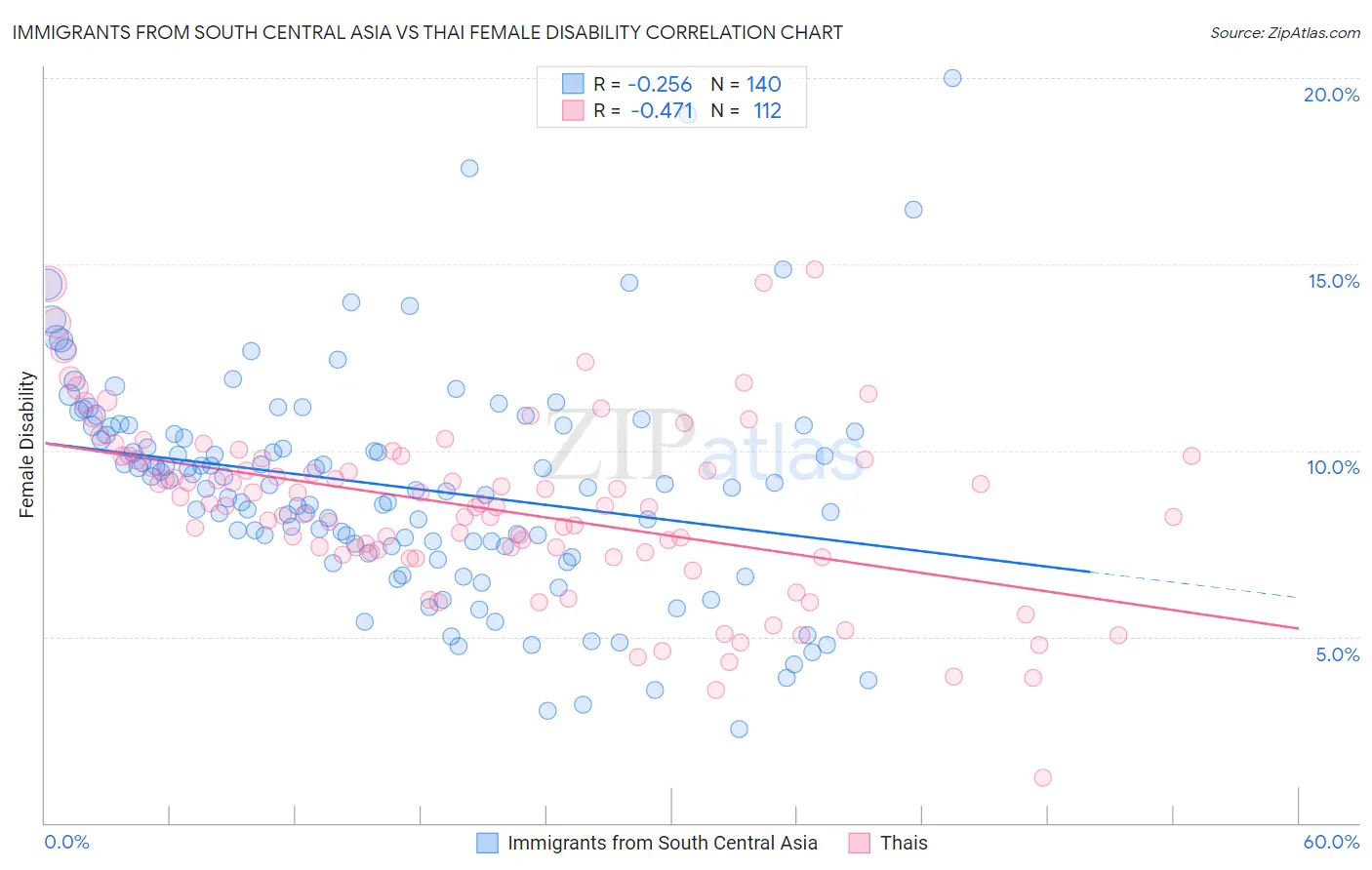Immigrants from South Central Asia vs Thai Female Disability
COMPARE
Immigrants from South Central Asia
Thai
Female Disability
Female Disability Comparison
Immigrants from South Central Asia
Thais
10.5%
FEMALE DISABILITY
100.0/ 100
METRIC RATING
8th/ 347
METRIC RANK
10.2%
FEMALE DISABILITY
100.0/ 100
METRIC RATING
4th/ 347
METRIC RANK
Immigrants from South Central Asia vs Thai Female Disability Correlation Chart
The statistical analysis conducted on geographies consisting of 473,039,804 people shows a weak negative correlation between the proportion of Immigrants from South Central Asia and percentage of females with a disability in the United States with a correlation coefficient (R) of -0.256 and weighted average of 10.5%. Similarly, the statistical analysis conducted on geographies consisting of 475,795,002 people shows a moderate negative correlation between the proportion of Thais and percentage of females with a disability in the United States with a correlation coefficient (R) of -0.471 and weighted average of 10.2%, a difference of 2.8%.

Female Disability Correlation Summary
| Measurement | Immigrants from South Central Asia | Thai |
| Minimum | 2.5% | 1.2% |
| Maximum | 20.0% | 14.9% |
| Range | 17.5% | 13.7% |
| Mean | 9.0% | 8.5% |
| Median | 9.0% | 8.5% |
| Interquartile 25% (IQ1) | 7.5% | 7.3% |
| Interquartile 75% (IQ3) | 10.6% | 9.8% |
| Interquartile Range (IQR) | 3.2% | 2.5% |
| Standard Deviation (Sample) | 3.0% | 2.4% |
| Standard Deviation (Population) | 3.0% | 2.4% |
Demographics Similar to Immigrants from South Central Asia and Thais by Female Disability
In terms of female disability, the demographic groups most similar to Immigrants from South Central Asia are Immigrants from Singapore (10.4%, a difference of 0.22%), Iranian (10.6%, a difference of 0.91%), Bolivian (10.4%, a difference of 1.0%), Immigrants from Hong Kong (10.6%, a difference of 1.6%), and Immigrants from Korea (10.6%, a difference of 1.7%). Similarly, the demographic groups most similar to Thais are Immigrants from Bolivia (10.3%, a difference of 0.82%), Immigrants from Taiwan (10.1%, a difference of 0.88%), Filipino (10.1%, a difference of 1.1%), Bolivian (10.4%, a difference of 1.7%), and Immigrants from India (10.0%, a difference of 2.1%).
| Demographics | Rating | Rank | Female Disability |
| Immigrants | India | 100.0 /100 | #1 | Exceptional 10.0% |
| Filipinos | 100.0 /100 | #2 | Exceptional 10.1% |
| Immigrants | Taiwan | 100.0 /100 | #3 | Exceptional 10.1% |
| Thais | 100.0 /100 | #4 | Exceptional 10.2% |
| Immigrants | Bolivia | 100.0 /100 | #5 | Exceptional 10.3% |
| Bolivians | 100.0 /100 | #6 | Exceptional 10.4% |
| Immigrants | Singapore | 100.0 /100 | #7 | Exceptional 10.4% |
| Immigrants | South Central Asia | 100.0 /100 | #8 | Exceptional 10.5% |
| Iranians | 100.0 /100 | #9 | Exceptional 10.6% |
| Immigrants | Hong Kong | 100.0 /100 | #10 | Exceptional 10.6% |
| Immigrants | Korea | 100.0 /100 | #11 | Exceptional 10.6% |
| Immigrants | Israel | 100.0 /100 | #12 | Exceptional 10.7% |
| Immigrants | Eastern Asia | 100.0 /100 | #13 | Exceptional 10.7% |
| Immigrants | China | 100.0 /100 | #14 | Exceptional 10.7% |
| Burmese | 100.0 /100 | #15 | Exceptional 10.7% |
| Okinawans | 100.0 /100 | #16 | Exceptional 10.8% |
| Indians (Asian) | 100.0 /100 | #17 | Exceptional 10.8% |
| Immigrants | Iran | 100.0 /100 | #18 | Exceptional 10.8% |
| Immigrants | Venezuela | 100.0 /100 | #19 | Exceptional 10.9% |
| Immigrants | Pakistan | 100.0 /100 | #20 | Exceptional 10.9% |